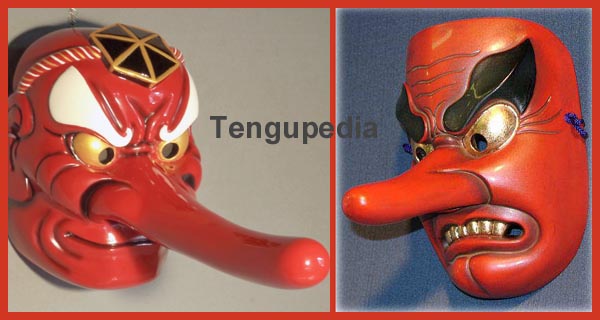. Onipedia - 鬼ペディア - Oni Demons - ABC-List - .
. aooni, ao-oni 青鬼 Blue or Green Oni Demon / kuro-oni 黒鬼 Black Demon .
:::::::::::::::::::::::::::::::::::::::::::::::::::::::::::::::::::::::::::::::::::::::::::::::::::::::::::::::::::::::::::::::::::::::::::::::::::::::::::::::::::::::::::::::::::
akaoni, aka-oni 赤鬼伝説 Red Oni Demon Legends

Together with his companion, the aooni, ao-oni 青鬼 Blue-Green Oni, he takes part in the Setsubun rituals.
. setsubun 節分 / せつぶん the Seasonal Divide .
February 3, the day before the beginning of spring (risshun 立春) according to the Asian lunar calendar.
:::::::::::::::::::::::::::::::::::::::::::::::::::::::::::::::::::::::::::::::::::::::::::::::::::::::::::::::::::::::::::::::::::::::::::::::::::::::::::::::::::::::::::::::::::
Aka-Oni 赤鬼 - - - Ii Naomasa 井伊直政, (1561 – 1602)
... The units Naomasa commanded on the battlefield were notable for being outfitted almost completely in blood-red armour (aka sonae 赤備え) for psychological impact, ... his unit became known as the "Red Devils", a nickname he shared with Yamagata Masakage,
- reference : wikipedia -
:::::::::::::::::::::::::::::::::::::::::::::::::::::::::::::::::::::::::::::::::::::::::::::::::::::::::::::::::::::::::::::::::::::::::::::::::::::::::::::::::::::::::::::::::::
Naita Akaoni 泣いた赤鬼 The Red Oni who cried
浜田廣介 Hamada Hirosuke (1893 - 1973)

- quote -
The Red Ogre Who Cried
Once upon a time, there were two ogres. One was red, and the other was blue.
The red ogre wanted to become friends with children in a village nearby. So, the red ogre put up a sign in front of his house:
Home of a Gentle Ogre
All Are Welcome
Tea and Tasty Cakes Available
But no one showed up, and the red ogre grew puzzled, sad, and angry. "I'm such a kind ogre -- why would nobody visit me?" Despairing, the red ogre even tore down the sign: "This is useless."
Moved by his friend's feelings, the blue ogre said, "Look, I have a plan."
The blue ogre's plan was for him to pretend to terrorize children and then have the red ogre chase him off, "rescuing" them from him. The plan went without a hitch, and the red ogre became the most popular creature among the children, and all came to play with him.
After a happy day of enjoying the children's company,
the red ogre found a letter from the blue ogre.
The letter said, "My Dear Red Ogre, if people find out that you are a friend of the Bad Blue Ogre's, they will not let the children come to you any more. So, I'm leaving. Please live happily with the children. Goodbye. Blue Ogre."
The red ogre cried out,
"Blue Ogre is gone! A dear friend of mine! He is gone!" And he wept.
The red ogre and the blue ogre were never to see each other again.
- source : montages.blogspot.jp/2006/04... -
:::::::::::::::::::::::::::::::::::::::::::::::::::::::::::::::::::::::::::::::::::::::::::::::::::::::::::::::::::::::::::::::::::::::::::::::::::::::::::::::::::::::::::::::::::
. Japanese Legends - 伝説 民話 昔話 – ABC-List .
............................................................................ Akita 秋田県
トトが町に出かけている間にアバのところに鬼がきた。アバは鬼ガ島まで連れて行かれた。トトも赤鬼、青鬼に鬼ガ島に連れて行かれ、アバの血を飲まされたが、鬼どもを退治して戻ってきた。
.......................................................................
Jizoo 地蔵,onidomo 鬼共 Jiso and the Demons
ヂンヂが地蔵にニギリをあたえ、雨具を着せてやった。地蔵は晩に鬼が博打をしているところにヂンヂを連れて行き、鶏の真似をさせて、金を手に入れさせた。隣のヂンヂが真似をしたが、笑ってしまったので鬼に気付かれて、赤鬼に食われてしまった。
............................................................................ Aomori 青森県
三戸郡 Sannone district 南郷村
oni oba 鬼おば old hag demon
旅のわらしが道に迷って一軒屋に泊まった。その家のおばあは赤鬼の面の鬼おばだった。赤子を串焼きにしているのを見てわらしは逃げ出し、炭焼きに助けられた。
............................................................................ Fukuoka 福岡県
. Festival at 若宮八幡宮 Wakamiya Hachimangu .
浮羽郡 Ukiha district, Yoshiimachi
............................................................................ Fukushima 福島県
東白川郡 Higashi-Shirakawa district 塙町
大昔、青鬼と赤鬼がいた。1軒の家に娘さんが何人かいて1年に1人ずつやっていた。親たちは娘をやりたくないと思っていたが、鬼の住んでいるそばまで連れて行った。そこで親子3人、菖蒲や蓬が生えている中へ飛び込んで身を隠した。すると鬼がわからないでそこを通ってしまった。それで五月節句には菖蒲と蓬を軒先に挿してすごす。
.......................................................................
Fukushima 飯坂町 Iizaka village
. Near-Death experience at age 33 .
............................................................................ Gifu 岐阜県
郡上市 Gujo town 和良村 Waramura
kitsune 狐 fox
夜、赤鬼と青鬼が相撲を取っていて、赤鬼が崖から落ちた。朝確かめてみると、人が死んでいた。狐の仕業。
............................................................................ Kyoto 京都府
右京区 Ukyo district
赤鬼,青鬼 Red Demon, Blue Demon
太秦の広隆寺では10月12日の夜に牛祭という珍祭が行われ、当日紙製の仮面5枚1組が出される。摩多罹神、青鬼2、赤鬼2の組み合わせである。この仮面は門戸に吊るされ厄病余けの呪禁とされる。
............................................................................ Miyagi 宮城県
昔、頓平 Tonpei という間抜け者がいた。働きもせず飯だけ一人前、唯一つ、弓を射るのが名人だった。とうとう家を追い出された頓平が、その夜道端で寝ていると、上の方のお堂で鬼たちが宴会を始めた。鬼はエンメ小槌(こづつ)をふって酒だの肴だのを出していた。頓平は鬼どもを驚かそうと一矢、また一矢と鬼を射ると、鬼たちはあわてて逃げていった。これを見た頓平はお堂に行き、エンメ小槌をふって飯、肴、家、美しい娘、馬、カゴ、と次々にそろえたが、調子にのって「俺の矢でみんな退治してやる」と「赤鬼、青鬼みんな出て来い」というと、鬼たちが大勢出てきて、頓平を殴ったり蹴ったりした挙句、深い谷間に突き落としてしまった。
.......................................................................
登米郡 Tome district 中田町 Nakadacho
赤鬼,青鬼 Red Demon, Blue Demon
刀鍛治が百本の刀を献上することになり、刀打ちを始めるにあたって、家内に仕事が終わるまで七日間絶対に鍛冶場に近寄るなと厳命した。ふしぎなことに相槌の音がするので、家内が厳命を破ってのぞいてみると、赤鬼・青鬼が相槌を打ち、主人が真っ赤に焼けた鉄を口に銜えて打っていた。家内が覗いたのを察したか相槌はやみ、鬼の姿は消えた。
............................................................................ Nagano 長野県
鼎町 Kanaemachi
hiki-ishi 蟇石 Toad-Stone
赤鬼に出会った男は、恐ろしくて足が動かなかったので、そこにあった石につかまって息を潜めた。赤尾は男を見つけられず、その石が蟇のような姿だったので、にらめっこをした。しかし蟇が動かないので怖気づいた赤鬼は死んでしまった。
............................................................................ Shiga 滋賀県
大津市 Otsu
大津市葛川の明王院には、豹の毛皮を腰に巻き、白いふんどしを締めた赤鬼と、諸肌を脱いだ筋骨隆々の男が向かい合って、綱を首にかけて首引きをしている絵馬がある。
............................................................................ Tokyo 東京都
青鬼,赤鬼 Blue Demon, Red Demon
ある人がお寺の2階のゲヤに寝ていると、青鬼と赤鬼がやってきてその人をさがしたが鶏が「トッテクショー」と鳴くと、鬼は「夜が明けるからぐずぐずしていると自分がつかまる」と言って帰った。
............................................................................ Yamagata 山形県
最上郡 Mogami district 真室川町 Mamurogawa
. 鬼に金棒 Oni ni kanabo - iron club legends .
:::::::::::::::::::::::::::::::::::::::::::::::::::::::::::::::::::::::::::::::::::::::::::::::::::::::::::::::::::::::::::::::::::::::::::::::::::::::::::::::::::::::::::::::::::
- reference : nichibun yokai database 妖怪データベース -
- reference - 赤鬼 -
:::::::::::::::::::::::::::::::::::::::::::::::::::::::::::::::::::::::::::::::::::::::::::::::::::::::::::::::::::::::::::::::::::::::::::::::::::::::::::::::::::::::::::::::::::

. - - - Join the Onipedia friends on facebook ! - - - .
:::::::::::::::::::::::::::::::::::::::::::::::::::::::::::::::::::::::::::::::::::::::::::::::::::::::::::::::::::::::::::::::::::::::::::::::::::::::::::::::::::::::::::::::::::
. Onipedia - 鬼ペディア - Oni Demons - ABC-List - .
. aooni, ao-oni 青鬼 Blue or Green Oni Demon .
. Tengu 天狗と伝説 Tengu legends "Long-nosed Goblin" .
. - yookai, yōkai 妖怪 Yokai monsters - .
. Legends and Tales from Japan 伝説 - Introduction .
. Mingei 民芸 Regional Folk Art from Japan .
:::::::::::::::::::::::::::::::::::::::::::::::::::::::::::::::::::::::::::::::::::::::::::::::::::::::::::::::::::::::::::::::::::::::::::::::::::::::::::::::::::::::::::::::::::
[ . BACK to DARUMA MUSEUM TOP . ]
[ . BACK to WORLDKIGO . TOP . ]
- #akaoni #reddemon -
:::::::::::::::::::::::::::::::::::::::::::::::::::::::::::::::::::::::::::::::::::::::::::::::::::::::::::::::::::::::::::::::::::::::::::::::::::::::::::::::::::::::::::::::::::









































